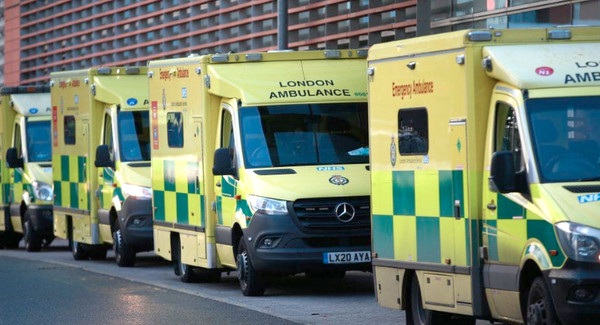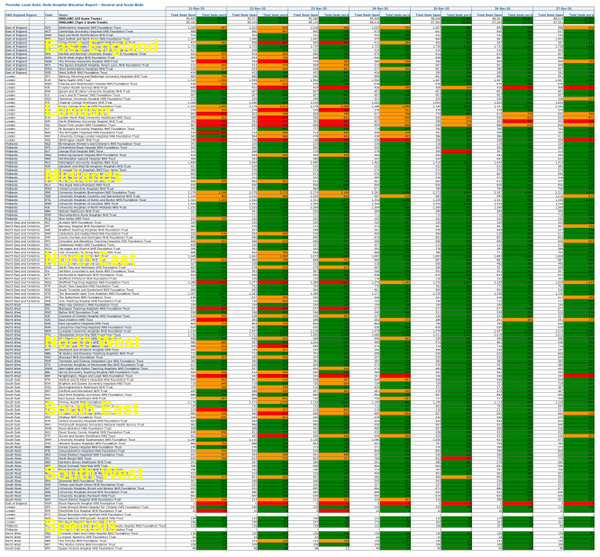Situation Still Normal

Much is being made in the main stream media of the pressures on the NHS, which is reported to be overwhelmed, or at least about to be overwhelmed. Grim images of ambulances stacked line the front pages, though this one, from the BBC two days ago, seems to have caught the moment when no one was at home. Dr No has lightened the image just a bit, the better to see inside the cabs, and all he can see is empty seats and head rests. Squads of medics and paramedics are on standby, ready to be interviewed on the detail in their corner of the NHS, and provide alarming predictions of imminent implosion. All this fits well with the Establishment/MSM mantra, that Coronageddon is just around the corner, but is it true? Is the NHS really about to implode?
The NHS this morning released the latest sit-rep, the daily numbers of general and adult and adult critical care beds available and occupied for acute trusts in England, covering the week from 21st to 27th December. Dr No has given them the same treatment as he gave last week’s figures. What we find is that, on average, general and adult bed occupancy in England is 83%, down from 89% in the previous week (this fall is normal, and due to Christmas), and still lower than rates (week 4 in this file) in 2019 (89%) and 2018 (88%). The picture for adult critical care beds is much the same: average occupancy is 76%, just down from 77% in the previous week, and down a bit or comparable to 2019 (79%) and 2018 (77%). These figures, the latest from only a few days ago, do not support the Establishment/MSM narrative. The NHS is not, or at least on 27th December, four days ago, was not, overwhelmed.
This is borne out again by Dr No’s traffic light indicators applied to the daily trust general and acute bed occupancy rates. Again, for consistency with the previous week, a red cell means occupancies of 95% or more, amber cells mean occupancies between 90 and 95%, and green cells mean occupancies under 90%. Figure 1 gives the picture.

Figure 1: overview of daily occupancy by trust/region (yellow text). Specials are the oddball mostly ultra-specialist hospitals eg Papworth. See text above for meaning of the colours. Larger pdf version available here.
Just as every picture tells a story, so in Figure 1 does every cell tell a story. The story is very clearly that, apart from a small number of localised hot spots, the NHS has not been overwhelmed. Christmas Day and Boxing Day, as expected, were particularly ‘situation normal’. Why, then, do the mainstream media continue pedal the myth of an overwhelmed, or about to be overwhelmed, NHS?

“Figure 1 gives the picture.” Not for me. How do the columns differ? Do they represent different weeks? If so, which?
I can’t read the tiny type and if I enlarge it it just gets fuzzy.
dearieme – fair point for the 600px wide image in the post, hence the link to the larger pdf version in the caption. Some of the methodology is in the previous post. Each of the coloured columns is a day, from 21 to 27th Dec, each row is a trust, with the larger yellow text on the left being the NHS region. The idea is to give an easily assimilated visual snapshot of the NHS as whole, the more red there is, the hotter things are (higher occupancy), the more green there is, the more things are normal (normal or less than normal occupancy). A bit like those stock market screens you see from time to time. The two mostly green columns, columns 5 and 6, are Christmas Day and Boxing Day, and these are traditionally quieter, because there is no elective activity, plus, at least in Dr No’s day, we tried to get people home for Christmas.
Ta.
The media love anything that gets stretched to bursting, be that a riverbank, an ecosystem or a health service. They don’t really care about the minor detail of whether there’s anything exceptional about it. They also don’t understand that capacity in a hospital is a constantly moving goal: If somebody young and fit enough to need an ITU bed arrives then a bed will always be found. Of course, the most tiresome argument throughout this saga is that we’re not interested in what’s happening now, it’s what’s going to happen in x week’s time. Ultimately it’s fear of a potential doomsday future that keeps this madness going.
dearieme – you have also helped Dr No spot an error/anomaly on the chart which got through Dr No’s random ‘are cell colours correct’ checks. The red cells for the specials Papworth and Moorfields are either wrong (Papworth, 0 out of 0 beds occupied nonetheless somehow but meaninglessly evaluates to 100% occupancy and so the cells are red, same thing happens in one Moorfields cell) or unlikely (Moorfields 10 out of 10 beds occupied on one day (100%) when on every other day there were no beds occupied (0%)). Were these errors to be corrected, there would be even less red on the chart…
PS the sit-reps are ‘quick and dirty stats, so also likely to be some reporting errors, but if the aim is to get an overall visual picture, as it is, then these shouldn’t alter the overall picture too much.
Shawn – yes, absolutely agree that it (the potential Doomsday future) is the most tiresome argument, because we can’t know the answer until we get there. But perhaps we can point out that rather an embarrassingly large number of past Doomsday predictions have failed, sometimes spectacularly so. But then, perhaps even more tiresomely, the cry goes up, we only avoided Doomsday because we took action! That of course if pure post hoc ergo propter hoc, and can be countered by the far from perfect but definitely better than nothing observations from the natural experiments that arise from different countries following different courses of action.
I had hoped that the natural experiments would be irrefutable evidence that a better path could have been trodden but, alas, it seems that there is no amount of hard evidence that will change the mind of the masses. I’m sure you’ve seen Malcolm Kendrick’s new post where he sums thing up nicely (and with obvious and understandable exasperation). He rightly points out that opinion has crystallised now and everyone is firmly adhered to their banner. It’s something I do try and challenge myself on from time to time and I think a useful way to progress the debate would be for each ‘side’ to admit some of the mistakes along the way (I can’t see that happening). So I do think that anyone still finding time to lay down their thoughts as you and others do is impressive now more than ever (since you surely know your audience is of one mind). Never the less I have looked forward to reading your posts over recent months and do hope you continue. It’s nice to know that your view may be firmly in the minority but is at least shared by someone. I wish you a Happy New Year. Shawn
Shawn – thanks for your kind remarks, and a Happy New Year to you too. One of Dr No’s most tongue in cheek regular remarks is the one about the only time he was wrong is when he said he wasn’t always right. The reality is he does spend a fair amount of time wondering if he has got it all wrong, but when he goes back to the data, the conclusions always come back the same. He also, whenever possible, uses a habit borrowed from navigation: if ever you can, always look at a problem using more than one set of instruments, and if the answers line up, then that improves likely validity (eg if radar says you are at point X, then check the echo sounder shows the depth you would expect at point X).
I have just recently added some comments to Malcolm Kendrick’s excellent post. The division and hardening of minds that we are all now so familiar with is tragic but oh-so-human, and even worse it is just the sort of fetid bed on which authoritarianism sows its vile seeds. Maybe the greatest challenge of 2021 won’t be how to manage that damn virus, but how to manage our flawed human reaction to that damn virus.
The same conclusion (situation normal) can also be readily applied to the media’s conduct and behaviour — pedalling BS, hyping up the narrative, creating moral panic across the country. A revisit to Radio 4 the other morning only confirms my belief that journalism appears to be dead. The reporter’s don’t ask questions, nor hold anyone’s feet to the fire — rather, be agreeable, encourage sentimental feelings and commentary to far outweigh the facts, information and fairness.
As we’re not likely to change how the media carry on any day soon, perhaps we should encourage them to latch onto something else to supersede or at least demote the current narrative?
Brexit > Covid > Another?
Suggestions welcome!
James – an intriguing option, encourage the mainstream media to be our useful idiots, rather than the government’s useful idiots. But a sad reflection of the state of Britain as we enter 2021, that many of us now see the media as useful idiots, rather than the guardians of democracy. But, hey ho, and a Happy New year to all! Dr No has no plans to stop writing any time soon.
“Maybe the greatest challenge of 2021 won’t be how to manage that damn virus, but how to manage our flawed human reaction to that damn virus”.
Very true, Dr No. (And a Happy New Year to you, with my thanks for all your hard work).
Trouble is, the very first thing we need is hard, reliable, indisputable data. And so many people, with such great resources, seem dedicated to making sure we don’t get it. Or, at the very least, that it is vigorously disputed.
“The media love anything that gets stretched to bursting, be that a riverbank, an ecosystem or a health service”.
Exactly so, Shawn. And of course the NHS is always on the verge of being swamped in winter – by design of successive governments, which seem to feel that the very worst outcome would be having a single bed, doctor, nurse or piece of equipment idle for even a moment.
The fallacy behind this should be obvious to anyone with a clear head, and was thoroughly debunked some time ago by Tom DeMarco in his excellent little book “Slack”. You can read a brief summary of its argument at Amazon, and the readers’ comments are also helpful. https://www.amazon.co.uk/Slack-Getting-Burnout-Busywork-Efficiency-ebook/dp/B004SOVC2Y/ref=sr_1_1?dchild=1&keywords=slack&qid=1609508412&sr=8-1
DeMarco points out what false economy it is to “cut overheads to the bone” and “trim all the fat”, both in business and in government. That is like going into battle with no reserves of fuel, ammunition or troops. Inevitably a surge in demand comes along, and basic queueing theory shows that big backlogs will then build up very rapidly. Backlogs appear fast, but take a long time to eliminate – if they don’t jam up the works permanently.
Politicians and administrators get praise for cutting costs and “waste”, but they manage to avoid blame when their short-sighted policies of penny pinching lead to disaster.